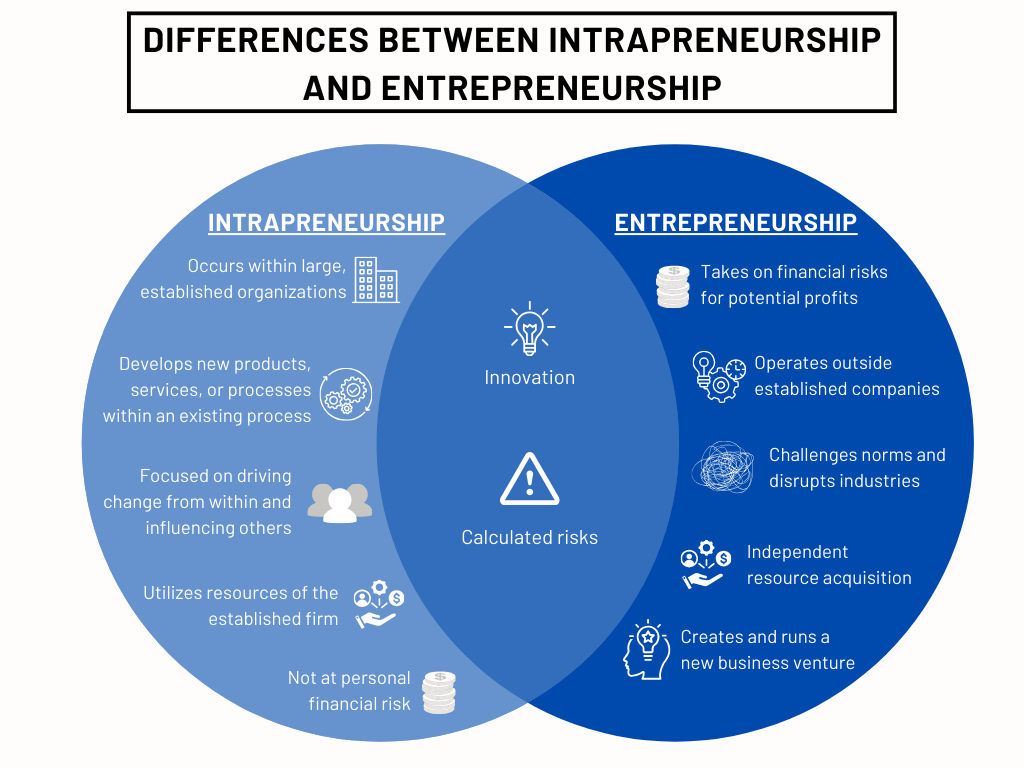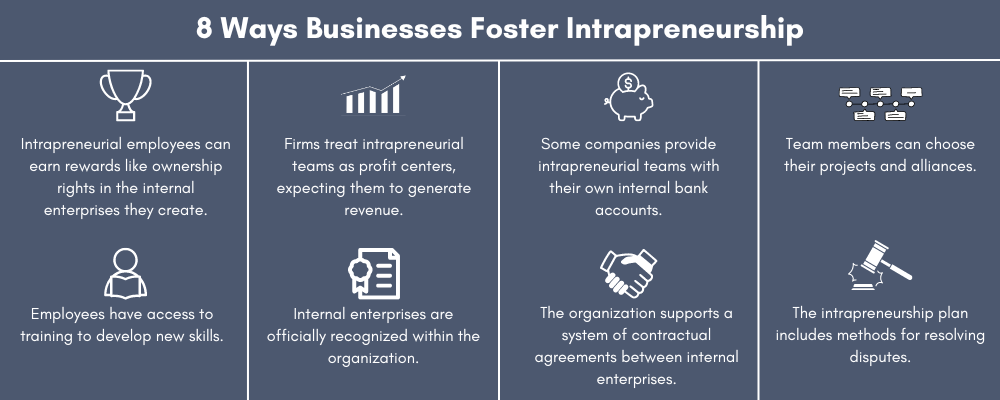Chapter 3: Intrapreneurship
What is Intrapreneurship?
Entrepreneurial spirit doesn’t only thrive in the startup world; it’s also a powerful force within established businesses. This unique blend of entrepreneurship within the safety net of a larger organization is what we call intrapreneurship. It harnesses the creativity and passion of entrepreneurs, allowing them to innovate and drive change from within the organization they work for (LibreTexts, 2024).
The primary difference between the two types of innovators is their context—the intrapreneur acts within the confines of an existing organization. An intrapreneur is someone who operates like an entrepreneur but has the backing of an organization. See Figure 3.1 for an illustration showing the differences between intrapreneurship and entrepreneurship. Intrapreneurs and entrepreneurs both focus on innovation and take risks, but their approaches and circumstances differ significantly.

In their book Re-Inventing the Corporation, John Naisbitt and Patricia Aburdene cited intrapreneurship as a way for established businesses to find new markets and new products.
Steve Jobs also described the development of the Macintosh computer as an intrapreneurial venture within Apple.
In 1990 the concept was established enough that Rosabeth Moss Kanter of the Harvard Business School discussed the need for intrapreneurial development as a key factor in ensuring the survival of the company in her book When Giants Learn to Dance.
A Short History of Intrapreneurship
Gifford and Elizabeth Pinchot coined the term “intrapreneur” in the early 1980s. They developed the concept of intra-corporate entrepreneurship. In their model, individuals interested in pursuing intrapreneurial projects had to risk something of value, like a portion of their salary. If successful, the intrapreneur could sell the project for cash bonuses and intracapital. This capital could then be used to fund future projects. The Pinchots established a school for intrapreneurs based on the success of their methods in Sweden. In 1985 they published their first book Intrapreneuring, combining the findings from their research and practical applications.
The Intrapreneurial Organization
An intrapreneurial organization is one that seeks to systematically promote the spirit of intrapreneurship in targeted parts of the organization. Firms like Merck & Co., 3M, Motorola, Newell Rubbermaid, Johnson & Johnson, Corning Incorporated, General Electric, Hewlett-Packard, Walmart, and others have impressive track records of innovation. This shows that being big does not necessarily hinder intrapreneurship.
These large firms are just a few out of thousands worldwide. Knowing the challenges faced by entrepreneurs in established firms will help them apply their knowledge of entrepreneurship to corporate intrapreneurship.
Intrapreneurs have helped increase the speed and cost-effectiveness of technology transfer from research and development to the marketplace.
The following are some methods that have been used by businesses to foster intrapreneurship, as shown in Figure 3.2.

Companies seeking to harness the advantages of intrapreneurs establish systems to identify employees with intrapreneurial characteristics. They then provide training and incentives to aid in the development of these employees.
The intrapreneurial organization can take on one or a combination of two forms: coexistence or structural separation.
- Coexistence: New venture activities are conducted within existing business units
- Structural separation: New, specialized business units are developed
Sharon Nunes is a vice president at IBM Technologies. Here, in an excerpt from a 2009 Women in Technology International newsletter, she relates her own experience as an intrapreneur at IBM:
The fact that I’m leading IBM’s Big Green Innovations group—focused on water management, alternative energy, and carbon management—isn’t a coincidence. It’s because I wanted to work on something I care deeply about, and I worked hard to raise awareness inside the company that this wasn’t just a good idea—it was imperative.
Our Big Green Innovations initiative was started as part of a $100 million investment in ten new businesses based on ideas generated during InnovationJam in 2006. IBM used Jams to enable broad collaboration, gain new perspectives on problems and challenges, and find important patterns and themes—all with the goal of accelerating decision-making and action. Jams are grounded in “crowdsourcing,” also known as “wisdom of the crowds.” This particular “crowd”—hundreds of thousands of IBMers, their families, and IBM customers—called resoundingly for an effort like Big Green Innovations. And so, it happened.
Pause and Reflect
- Do you see yourself being an entrepreneur or intrapreneur? Why?
- Do you think your skill set needs to be different for one versus the other? Why or why not?
Intrapreneurship in Action
Gifford Pinchot’s book Intrapreneuring: Why You Don’t Have to Leave the Corporation to Become an Entrepreneur provides ten commandments for intrapreneurs (LibreTexts, 2024):
- Do any job needed to make your project work, regardless of your job description.
- Share credit wisely.
- Remember, it is easier to ask for forgiveness than permission.
- Come to work each day willing to be fired.
- Ask for advice before asking for resources.
- Follow your intuition about people; build a team of the best.
- Build a quiet coalition for your idea; early publicity triggers the corporate immune system.
- Never bet on a race unless you are running in it.
- Be true to your goals, but realistic about ways to achieve them.
- Honor your sponsors.
Google’s 20% Rule
Google lets its technical employees spend up to 20 percent of their time on projects of their own choosing. This freedom is a “license to pursue your dreams,” as Google’s Marissa Mayer, one-time VP of search products, called it in Fast Company magazine. In 2006 Mayer said that half of the new products and features launched by Google in the last six months of 2005 came from work done under the “20% Rule (Salter, 2008).”
Key Takeaways
- Intrapreneurship is the practice of entrepreneurial behavior within the confines of a larger, established organization, leveraging the organization’s resources while fostering innovation and creativity.
- Intrapreneurship has been pivotal in major corporations, with examples like Steve Jobs describing the development of the Macintosh at Apple as an intrapreneurial effort.
- Companies such as Merck, 3M, Motorola, and others have demonstrated that large firms can successfully foster intrapreneurship by promoting innovation and systematically identifying and developing intrapreneurial employees.
- Companies foster intrapreneurship by creating systems to identify employees with intrapreneurial traits, providing them with training, and offering incentives. An example includes Google’s “20% Rule,” allowing employees to spend part of their time on personal projects.
Knowledge Check
An intrapreneur is someone working in a business who receives encouragement to think like an entrepreneur and develop fresh perspectives that can lead to new ideas for the company. These workers may have more freedom, but the organization still has control over the project and takes on any associated risks.

